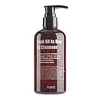What's inside
What's inside
 Key Ingredients
Key Ingredients

 Benefits
Benefits

 Concerns
Concerns

 Ingredients Side-by-side
Ingredients Side-by-side

Water
Skin ConditioningLauramide DEA
Sodium Laureth Sulfate
CleansingTea-Lauryl Sulfate
CleansingSnail Secretion Filtrate
Skin ConditioningSodium Lauryl Sulfate
CleansingPEG-7 Glyceryl Cocoate
EmulsifyingCocamidopropyl Betaine
CleansingPotassium Cocoyl Glycinate
Sodium Cocoyl Isethionate
CleansingDipropylene Glycol
HumectantChlorphenesin
AntimicrobialCitric Acid
BufferingBetaine
HumectantPanthenol
Skin ConditioningTocopheryl Acetate
AntioxidantCamellia Sinensis Leaf Extract
AntimicrobialGinkgo Biloba Leaf Extract
Skin ConditioningCentella Asiatica Extract
CleansingDisodium EDTA
Lavandula Angustifolia Flower Extract
CleansingViola Tricolor Extract
EmollientCentaurea Cyanus Flower Extract
AstringentButylene Glycol
HumectantPentylene Glycol
Skin ConditioningMethylisothiazolinone
Preservative1,2-Hexanediol
Skin ConditioningCaprylyl Glycol
EmollientParfum
MaskingWater, Lauramide DEA, Sodium Laureth Sulfate, Tea-Lauryl Sulfate, Snail Secretion Filtrate, Sodium Lauryl Sulfate, PEG-7 Glyceryl Cocoate, Cocamidopropyl Betaine, Potassium Cocoyl Glycinate, Sodium Cocoyl Isethionate, Dipropylene Glycol, Chlorphenesin, Citric Acid, Betaine, Panthenol, Tocopheryl Acetate, Camellia Sinensis Leaf Extract, Ginkgo Biloba Leaf Extract, Centella Asiatica Extract, Disodium EDTA, Lavandula Angustifolia Flower Extract, Viola Tricolor Extract, Centaurea Cyanus Flower Extract, Butylene Glycol, Pentylene Glycol, Methylisothiazolinone, 1,2-Hexanediol, Caprylyl Glycol, Parfum
Water
Skin ConditioningEthylhexyl Methoxycinnamate
UV AbsorberGlycerin
HumectantPropylene Glycol
HumectantCyclopentasiloxane
EmollientPhenylbenzimidazole Sulfonic Acid
UV AbsorberBis-Ethylhexyloxyphenol Methoxyphenyl Triazine
Skin ConditioningDicaprylyl Carbonate
EmollientIsoamyl P-Methoxycinnamate
UV AbsorberPotassium Cetyl Phosphate
EmulsifyingAlcohol
AntimicrobialDimethicone
EmollientButylene Glycol
HumectantGlyceryl Stearate
EmollientTitanium Dioxide
Cosmetic ColorantC14-22 Alcohols
Emulsion StabilisingPolymethyl Methacrylate
Cetearyl Alcohol
EmollientPEG-100 Stearate
Triethanolamine
BufferingSilica
AbrasiveSodium Hydroxide
BufferingDimethicone/Vinyl Dimethicone Crosspolymer
Skin ConditioningC12-20 Alkyl Glucoside
EmulsifyingAluminum Hydroxide
EmollientStearic Acid
CleansingParfum
MaskingCaprylyl Glycol
EmollientPhenoxyethanol
PreservativeAcrylates/C10-30 Alkyl Acrylate Crosspolymer
Emulsion StabilisingAloe Arborescens Leaf Extract
MoisturisingDipotassium Glycyrrhizate
HumectantCarbomer
Emulsion StabilisingXanthan Gum
EmulsifyingLimonene
PerfumingTocopheryl Acetate
AntioxidantDisodium EDTA
Hexyl Cinnamal
PerfumingLinalool
PerfumingBenzyl Salicylate
PerfumingGeraniol
PerfumingBenzyl Alcohol
PerfumingCitronellol
PerfumingBenzyl Benzoate
AntimicrobialCitral
PerfumingWater, Ethylhexyl Methoxycinnamate, Glycerin, Propylene Glycol, Cyclopentasiloxane, Phenylbenzimidazole Sulfonic Acid, Bis-Ethylhexyloxyphenol Methoxyphenyl Triazine, Dicaprylyl Carbonate, Isoamyl P-Methoxycinnamate, Potassium Cetyl Phosphate, Alcohol, Dimethicone, Butylene Glycol, Glyceryl Stearate, Titanium Dioxide, C14-22 Alcohols, Polymethyl Methacrylate, Cetearyl Alcohol, PEG-100 Stearate, Triethanolamine, Silica, Sodium Hydroxide, Dimethicone/Vinyl Dimethicone Crosspolymer, C12-20 Alkyl Glucoside, Aluminum Hydroxide, Stearic Acid, Parfum, Caprylyl Glycol, Phenoxyethanol, Acrylates/C10-30 Alkyl Acrylate Crosspolymer, Aloe Arborescens Leaf Extract, Dipotassium Glycyrrhizate, Carbomer, Xanthan Gum, Limonene, Tocopheryl Acetate, Disodium EDTA, Hexyl Cinnamal, Linalool, Benzyl Salicylate, Geraniol, Benzyl Alcohol, Citronellol, Benzyl Benzoate, Citral
 Reviews
Reviews

Ingredients Explained
These ingredients are found in both products.
Ingredients higher up in an ingredient list are typically present in a larger amount.
Butylene Glycol (or BG) is used within cosmetic products for a few different reasons:
Overall, Butylene Glycol is a safe and well-rounded ingredient that works well with other ingredients.
Though this ingredient works well with most skin types, some people with sensitive skin may experience a reaction such as allergic rashes, closed comedones, or itchiness.
Learn more about Butylene GlycolCaprylyl Glycol is a humectant and emollient, meaning it attracts and preserves moisture.
It is a common ingredient in many products, especially those designed to hydrate skin. The primary benefits are retaining moisture, skin softening, and promoting a healthy skin barrier.
Though Caprylyl Glycol is an alcohol derived from fatty acids, it is not the kind that can dry out skin.
This ingredient is also used as a preservative to extend the life of products. It has slight antimicrobial properties.
Learn more about Caprylyl GlycolDisodium EDTA plays a role in making products more stable by aiding other preservatives.
It is a chelating agent, meaning it neutralizes metal ions that may be found in a product.
Disodium EDTA is a salt of edetic acid and is found to be safe in cosmetic ingredients.
Learn more about Disodium EDTAParfum is a catch-all term for an ingredient or more that is used to give a scent to products.
Also called "fragrance", this ingredient can be a blend of hundreds of chemicals or plant oils. This means every product with "fragrance" or "parfum" in the ingredients list is a different mixture.
For instance, Habanolide is a proprietary trade name for a specific aroma chemical. When used as a fragrance ingredient in cosmetics, most aroma chemicals fall under the broad labeling category of “FRAGRANCE” or “PARFUM” according to EU and US regulations.
The term 'parfum' or 'fragrance' is not regulated in many countries. In many cases, it is up to the brand to define this term.
For instance, many brands choose to label themselves as "fragrance-free" because they are not using synthetic fragrances. However, their products may still contain ingredients such as essential oils that are considered a fragrance by INCI standards.
One example is Calendula flower extract. Calendula is an essential oil that still imparts a scent or 'fragrance'.
Depending on the blend, the ingredients in the mixture can cause allergies and sensitivities on the skin. Some ingredients that are known EU allergens include linalool and citronellol.
Parfum can also be used to mask or cover an unpleasant scent.
The bottom line is: not all fragrances/parfum/ingredients are created equally. If you are worried about fragrances, we recommend taking a closer look at an ingredient. And of course, we always recommend speaking with a professional.
Learn more about ParfumTocopheryl Acetate is AKA Vitamin E. It is an antioxidant and protects your skin from free radicals. Free radicals damage the skin by breaking down collagen.
One study found using Tocopheryl Acetate with Vitamin C decreased the number of sunburned cells.
Tocopheryl Acetate is commonly found in both skincare and dietary supplements.
Learn more about Tocopheryl AcetateWater. It's the most common cosmetic ingredient of all. You'll usually see it at the top of ingredient lists, meaning that it makes up the largest part of the product.
So why is it so popular? Water most often acts as a solvent - this means that it helps dissolve other ingredients into the formulation.
You'll also recognize water as that liquid we all need to stay alive. If you see this, drink a glass of water. Stay hydrated!
Learn more about Water